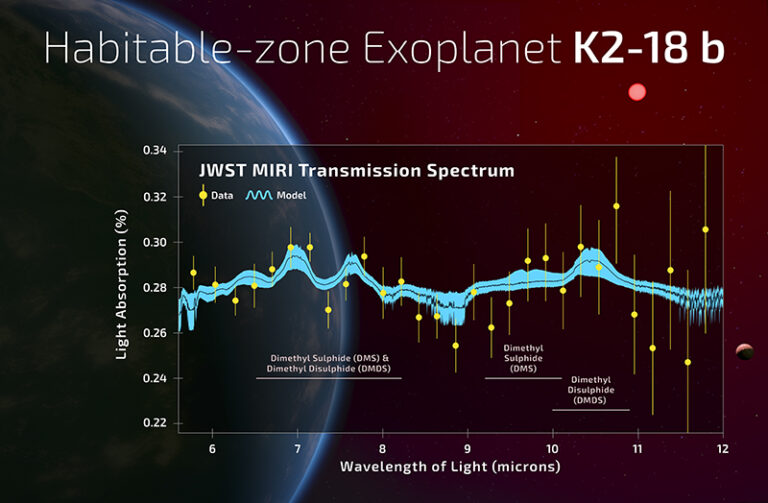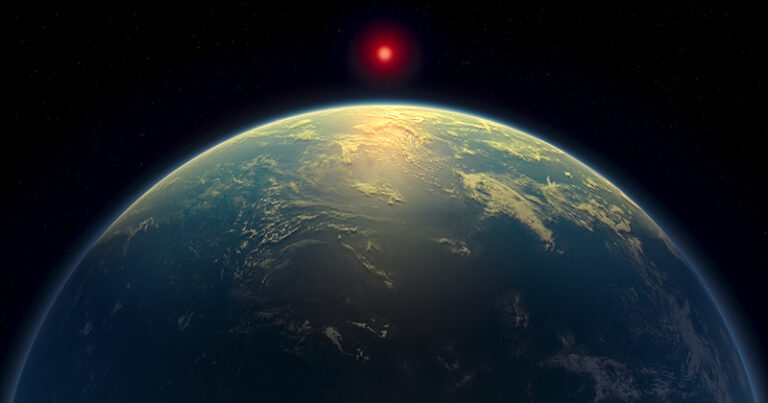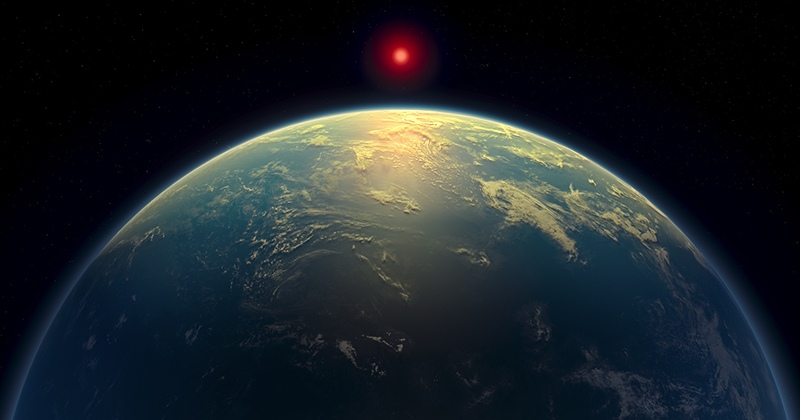
Life Signals? JWST Discovers Key Biosignatures in the Atmosphere of a Distant Planet
A flicker of light through a spectrograph may have brought us closer to answering one of humanity’s biggest questions: are we alone? A study published on April 17, 2025, in The Astrophysical Journal Letters reveals groundbreaking mid-infrared observations of the exoplanet K2-18 b, hinting at molecules linked to life on Earth. Led by Dr. Nikku Madhusudhan from the University of Cambridge, these findings mark a pivotal moment in the search for extraterrestrial life.
A Grain of Sand That Could Change Everything
The planet K2-18 b orbits a red dwarf star approximately 124 light-years from Earth in the constellation Leo. With a mass roughly 8.6 times that of Earth and a radius 2.6 times larger, it occupies the intriguing boundary between super-Earths and mini-Neptunes. Previous observations with JWST’s near-infrared instruments had already detected carbon-bearing molecules like methane (CH₄) and carbon dioxide (CO₂) in its atmosphere, establishing it as a promising candidate for what scientists call a “hycean world“—a planet with a habitable ocean-covered surface beneath a hydrogen-rich atmosphere.
These new observations, conducted with JWST’s Mid-Infrared Instrument (MIRI), provide the first glimpse of K2-18 b at longer wavelengths (approximately 6-12 micrometers), revealing spectral features that appear to be best explained by dimethyl sulfide (DMS) and/or dimethyl disulfide (DMDS). Both compounds are considered robust potential biosignature gases, as on Earth they are produced almost exclusively by living organisms, particularly marine microbes like phytoplankton.
“This is an independent line of evidence, using a different instrument than we did before and a different wavelength range of light, where there is no overlap with the previous observations,” explains Dr. Nikku Madhusudhan of the University of Cambridge, the study’s lead author. “The signal came through strong and clear.”

Statistical Significance and Scientific Caution
The findings have reached what scientists call a “three-sigma” level of statistical confidence. This means there’s only a 0.3% chance the signal is merely a random fluctuation rather than a genuine detection. While impressive, this still falls short of the “five-sigma” threshold (less than a 0.00006% chance of being due to random variation) that scientists typically require to claim a definitive discovery.
“It was an incredible realization seeing the results emerge and remain consistent throughout the extensive independent analyses and robustness tests,” notes co-author Måns Holmberg, a researcher at the Space Telescope Science Institute in Baltimore.
The researchers believe that between 16 and 24 additional hours of observation time with JWST may help them reach the all-important five-sigma significance needed for confirmation.
Unprecedented Concentrations Raise Intriguing Questions
What makes these findings particularly striking is the concentration of these potential biosignature compounds. On Earth, DMS and DMDS typically exist at levels below one part per billion by volume in the atmosphere. On K2-18 b, however, their abundance appears to be thousands of times greater—over ten parts per million.
“Earlier theoretical work had predicted that high levels of sulfur-based gases like DMS and DMDS are possible on hycean worlds,” says Dr. Madhusudhan. “And now we’ve observed it, in line with what was predicted. Given everything we know about this planet, a hycean world with an ocean that is teeming with life is the scenario that best fits the data we have.”
While the implications are tantalizing, Dr. Madhusudhan emphasizes the need for caution. There could be previously unknown chemical processes occurring on K2-18 b that might account for the observations through non-biological means. His team is planning further theoretical and experimental work to investigate whether DMS and DMDS could be produced abiotically at the levels currently detected.

The Challenge of Confirmation
Despite the excitement surrounding these findings, the scientific community maintains appropriate caution. The spectral signatures of DMS and DMDS overlap significantly in the mid-infrared range, making it difficult to conclusively distinguish between them. Moreover, while both molecules are considered robust biosignatures on Earth, the possibility of yet-unknown abiotic production pathways in exotic environments cannot be completely ruled out.
“The inference of these biosignature molecules poses profound questions concerning the processes that might be producing them,” says co-author Subhajit Sarkar of Cardiff University. “Our work is the starting point for all the investigations that are now needed to confirm and understand the implications of these exciting findings,” adds co-author Savvas Constantinou from Cambridge’s Institute of Astronomy.
“It’s important that we’re deeply skeptical of our own results,” Dr. Madhusudhan emphasizes, “because it’s only by testing and testing again that we will be able to reach the point where we’re confident in them. That’s how science has to work.”
Beyond a Single World
The implications of this discovery extend far beyond K2-18 b itself. If confirmed, it would validate the “hycean world” concept as a promising avenue for the search for extraterrestrial life—potentially expanding the habitable zone around stars and increasing the number of potentially life-bearing worlds within observational reach.
While not yet claiming a definitive discovery, Dr. Madhusudhan suggests that with powerful tools like JWST and future planned telescopes, humanity is taking new steps toward answering that most essential of questions: are we alone?
“Decades from now, we may look back at this point in time and recognize it was when the living universe came within reach,” reflects Dr. Madhusudhan. “This could be the tipping point, where suddenly the fundamental question of whether we’re alone in the universe is one we’re capable of answering.”
The James Webb Space Telescope is a collaboration between NASA, ESA and the Canadian Space Agency (CSA). The research is supported by a UK Research and Innovation (UKRI) Frontier Research Grant.
